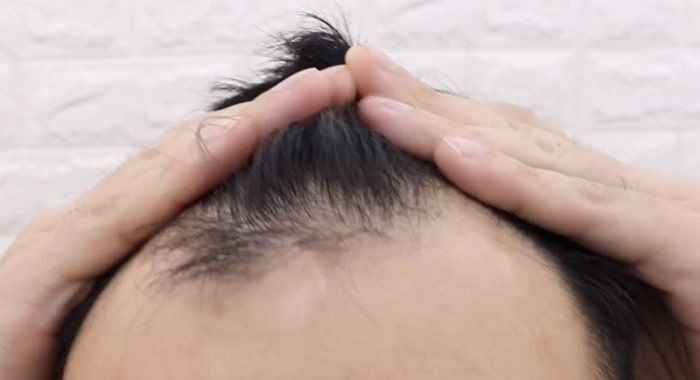
A receding hairline is the main reason that most men visit this blog. Women usually suffer from a more diffuse pattern of hair loss, although some of them also get hairline recession. In younger people, receding hairlines can cause tremendous stress due to making one look much older.
This is an informational post that was required in order for me to summarize some general information and links to past posts in one place. If you suffer from hair loss, make sure to check out my page on the best hair loss shampoos for your needs.
Receding Hairline Stages in Men

A receding hairline is typically used to describe the progressive nature of male pattern hair loss. The latter is also known as male pattern baldness (MPB) or androgenetic alopecia (AGA).
The hair loss usually starts with the temples slowly receding backwards with time. This often leaves one with a prominent widow’s peak. The actual stages of hair loss in men are classified under the Norwood Scale (or Hamilton-Norwood scale). In MPB, anagen phase hair follicles go through shorter and shorter cycles before reaching telogen phase and shedding.
For women, female pattern baldness is usually seen in a much more diffuse and spread out pattern. However, there are some types of hair loss disorders such as frontal fibrosing alopecia and traction alopecia that can cause receding hairlines in women too.
What Causes a Receding Hairline?
The average man has around 90,000-150,000 hair follicles on his head depending on hair color. Most men will slowly start losing some of these follicles starting in their late teens and early 20s after the end of puberty. The pace of this permanent loss of hair will vary tremendously depending on person. Note that it is common to shed 50-100 hairs per day without the hair loss being permanent.
The main cause of receding hairlines in men is genetics and family history. If you have been cursed with the problematic hair loss gene(s), your hair follicles are much more susceptible to the ravages of dihydrotestosterone (DHT).
Some people will lose hardly any hairs permanently until they are in their 50s or 60s, while others will become bald as a cue ball by age 20. Nevertheless, most men will have a visibly receding hairline by middle age as the adverse combined influence of hormones and aging diminishes follicle regeneration capacity.
Receding Hairline Treatment Options
You have a number of options to treat your receding hairline, with each of these having significant advantages and disadvantages. Many people opt for a combination of the below treatments. None of them represent a true receding hairline cure.
Medications
There are two main FDA approved medications to treat male pattern hair loss (androgenetic alopecia):
- The first of these is Finasteride, which is FDA approved to treat hair loss in men. The oral drug works by reducing dihydrotestosterone (DHT) levels significantly, but it must be taken forever or else the hair loss will restart. Finasteride drastically reduces the 5α-reductase enzyme’s ability to convert testosterone into DHT. Some people who take the drug do get significant side effects, although the majority seem to tolerate it well. Women should not even come into contact with the drug when trying to get pregnant.
- The second of these is Minoxidil, which is a topical product to treat hair loss via an entirely different mechanism (see how Minoxidil works) from Finasteride. It must be applied daily (ideally twice per day) on a permanent basis
A third option is a powerful drug called Dutasteride that has been approved to treat hair loss in some countries, but not in the US. Dutasteride is essentially a much stronger version of Finasteride with greater potential for hair regrowth as well as for side effects.
A fourth option is anti-androgen therapy that entails taking drugs that can sometimes significantly feminize you. Note that some hair loss shampoos can also improve your hair quality.
Hair Transplants
If you do not want to use either of the above medications, there are other options out there. The most popular choice of all is getting a hair transplant surgical procedure to fix a receding hairline. Hair transplants are especially effective when a person’s hair loss is largely limited to the frontal region of the scalp (with the crown area not being too thin). For example, see Elon Musk’s hair transplant results for one such example. The presence of thicker and plentiful donor hair also makes hair transplant end results look much better.
The main limitations of hair transplants are the lack of unlimited donor hair in all people, and the fairly significant cost of hair transplants. Moreover, most people will need at least two such procedures over their lifetimes. Permanent scarring is also a potential side effect when getting a hair restoration procedure, even in the hands of the best surgeons out there.
Hair Systems or Toupees
Another option is getting a hair system, hairpiece or toupee. Modern day customized hair systems are fairly unnoticeable and long-lasting. In fact, I did a survey on this blog in the past on whether people would be willing to wear a hairpiece. Almost half of people responded with a “yes” or “maybe”. The main disadvantages of hairpieces are that they must be regularly maintained; are fairly costly; and can still be noticeable in certain situations such as on very windy and rainy days, or when swimming.
Other Hairline Receding Treatments
- Scalp Micropigmentation procedures can make you look like you have a full head of hair that has just been shaved down all the way via a buzz cut. Looks better on certain hair and skin types.
- If you still have a substantial quantity of hair left on your scalp, you can cover the few in-between balding and thinning areas with a hair loss concealer.
- For those who prefer the natural route, there are some natural treatments that will reduce hair fall and regrow some hair. However, usually these do not work as well as the proven FDA approved medications.
The Top 5 Hairstyles & Haircuts for Men with Receding Hairlines
If you do have a receding hairline, you must make sure to go for a hairstyle that suits your particular facial and bone structure. When getting a haircut, make sure to ask your stylist for his or her opinion on the best hairstyle for your thinning hair. A combover is a complete no-no for hiding your hair loss recession and belongs in the dustbins of fashion history.
Among the most popular haircuts for a receding hairline include:
- Clean Shave. The best option if you are willing to go through with it and forget about your hair loss once and for all. Often works well in tandem with a goatee or beard.
- Buzz Cut. The cleanest and most popular haircut for receding hairlines, although not everyone likes such short hair. Works best on certain hair and face types. One popular version of it is the crew cut.
- French Crop. A modern low maintenance men’s hairstyle for those with short hair. Best for those with few visibly thinning balding areas.
- Spiky Hair. A range of options in this style where the spiky hair with gel in it can hide or camouflage problematic balding areas. Requires you to have at least a moderate amount of thick remaining hair that can be spiked.
- Comb-It-Forward. A hairstyle in which the hair on top is combed forward (rather than to the side or to the back or spiked upwards). One popular version of this is the Caesar Cut that was popular with the balding Julius Caesar.